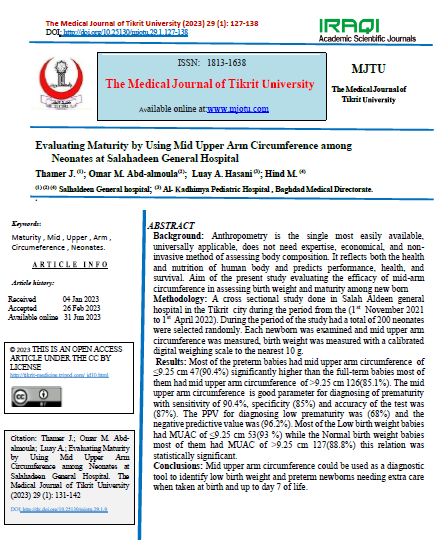Evaluating Maturity by Using Mid Upper Arm Circumference among Neonates at Salahadeen General Hospital
Thamer J Thamer J
Salhaldeen General hospital
Omar M. Abd- almoula
Salhaldeen General hospital
Luay A. Hasani
Kadhimya Pediatric Hospital , Baghdad Medical Directorate
Hind M Hind M
Salhaldeen General hospital
DOI: https://doi.org/10.25130/mjotu.29.2023.1.127-138
Keywords: Maturity , Mid , Upper , Arm , Circumeference , Neonates
Abstract
Background: Anthropometry is the single most easily available, universally applicable, does not need expertise, economical, and non-invasive method of assessing body composition. It reflects both the health and nutrition of human body and predicts performance, health, and survival. Aim of the present study evaluating the efficacy of mid-arm circumference in assessing birth weight and maturity among new bornMethodology: A cross sectional study done in Salah Aldeen general hospital in the Tikrit city during the period from the (1st November 2021 to 1st April 2022). During the period of the study had a total of 200 neonates were selected randomly. Each newborn was examined and mid upper arm circumference was measured, birth weight was measured with a calibrated digital weighing scale to the nearest 10 g.Results: Most of the preterm babies had mid upper arm circumference of ≤9.25 cm 47(90.4%) significantly higher than the full-term babies most of them had mid upper arm circumference of >9.25 cm 126(85.1%). The mid upper arm circumference is good parameter for diagnosing of prematurity with sensitivity of 90.4%, specificity (85%) and accuracy of the test was (87%). The PPV for diagnosing low prematurity was (68%) and the negative predictive value was (96.2%). Most of the Low birth weight babies had MUAC of ≤9.25 cm 53(93 %) while the Normal birth weight babies most of them had MUAC of >9.25 cm 127(88.8%) this relation was statistically significant.Conclusions: Mid upper arm circumference could be used as a diagnostic tool to identify low birth weight and preterm newborns needing extra care when taken at birth and up to day 7 of life





